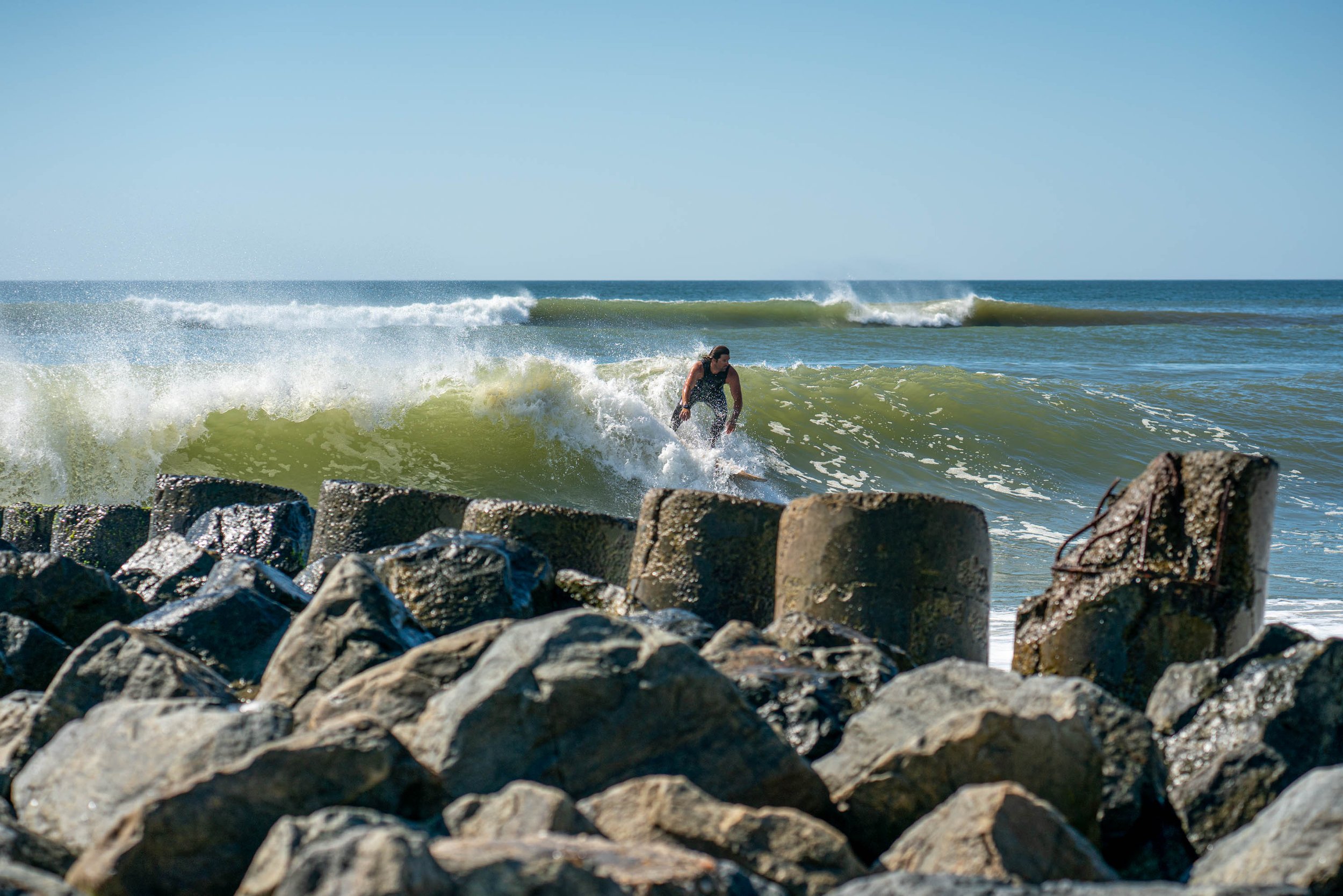
Maki Ragusa catching a wave by the Ocean Beach jetties. Courtesy of Robert Sherman.
On an island where natural beauty dominates the vistas, the Ocean Beach jetties stand out among but a few man-made landmarks dotting the barrier beach – but will soon be just a memory.
The groins, as the pair of concrete formations jutting 200 feet from the village beach into the Atlantic Ocean surf zone are also known, are slated to be removed as part of the $1.7 billion Fire Island Inlet to Montauk Point Project (FIMP). That project got underway in 2021 after a half century of debate and planning, ironically about the same length of time since the jetties were built. The jetties have been a fixture in the village for half of its century in existence.
“This summer for the first time there hasn’t been any real worry about erosion,” former Ocean Beach Mayor Arthur Silsdorf told The New York Times in an Aug. 1, 1971, article about the village’s dual jetties being completed that year.
The idea at the time was that the jetties would prevent erosion of the oceanfront by blunting the waves and capturing sand as it naturally flows from east to west along the South Shore of Long Island in what’s known as the littoral drift. But the jetties in turn starved downdrift areas of sand, exacerbating erosion in neighboring beaches to the west.
The effectiveness of the Ocean Beach jetties have been debated for as long as they have been sunk into the sand, becoming a topic that is not uncommon to come up at the village board meetings decades later. But now that FIMP is finally underway, the U.S Corps of Engineers (ACE) is preparing to rip them out as the storm mitigation project advances its goal of improving the shore’s ability to withstand future coastal storm surges and reduce flooding. ACE announced this spring the completion of the first two of 11 contracts in FIMP – a pair of subprojects to dredge more than a million cubic yards of sand combined from all five South Shore inlets: the East Rockaway Inlet, Jones Inlet, Fire Island Inlet, Moriches Inlet and Shinnecock Inlet. The sand dredged from those inlets were placed on adjacent beaches to build them back up.
“We’re proud to be the state partner in this effort with the U.S. Army Corps of Engineers to protect Long Island’s coastal communities by reducing flood risks,” New York State Department of Environmental Conservation Commissioner Basil Seggos said. “Climate change is driving an uptick in both severe storms and flooding. To safeguard our communities and our natural resources, we must continue to work together on the federal, state, and local levels on projects like this to increase storm resiliency.”
Dredge operations are on hold for summer – officials prefer not to have massive tubes pumping sand onto beaches and bulldozers building berms during peak tourist season when the shores are at full capacity – but are expected to resume the work this fall after the next round of contracts are awarded. But once the work resumes and before attention turns to the village jetties, ACE first needs to move the Ocean Beach water well back from oceanfront, a project that the village has been preparing for since Superstorm Sandy in 2012.
“They’re talking September,” Ocean Beach Mayor James Mallott said of ACE’s anticipated timeline for the two federally funded projects coming to the village.
ACE did not respond to requests for comment on the timetable for the project to replace the well and remove the groins, but it has addressed the need.
“To help facilitate the movement of this sand and restore the natural cross barrier island transport of sand in the region, two unneeded groins will be removed at Fire Island’s Ocean Beach Village,” the agency said in a statement, referring to the littoral drift. Other jetties – including those to the east in the Hamptons – are not expected to be removed, however.
Unlike most jetties on Long Island, the Ocean Beach groins are made with Sta-Pods: 5-foot tall concrete cylinders weighing two tons each with 9-foot wide interlocking legs.
“Because of its unique shape and interlocking design, it can provide a long lasting, stable toe for any slope,” according to a Sta Pod brochure published by The Fort Miller Company, the Schuylerville-based manufactures that make the devices.
The jetties had cost a quarter of a million dollars to install, or $1.8 million in today’s dollars. The first one cost $150,000 and the second was $100,000 because it used a mix of Sta-Pods and less expensive rocks, according to the Times. New York State paid 70% of the bill and the village covered the other 30%. How much they’ll cost to remove remains to be seen.
These days, when not subject of debate over the wisdom of trying to control the ocean by building hard structures on the sand, the jetties sometimes find themselves the focus of local artists whose work romanticizes the controversial structures. Like the Fire Island Lighthouse museum’s gallery documenting pre-modern life on the beach, jetty art may soon serve as a historical record of once was.























